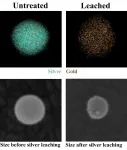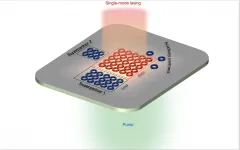New species of dumbo octopus identified using minimally invasive techniques
2021-04-23
(Press-News.org) A new species of deep-sea dwelling dumbo octopus called Grimpoteuthis imperator sp. nov. has been described using a combination of MRI, micro-CT and minimally invasive gene analysis rather than traditional dissection methods. The findings are presented in the open access journal BMC Biology.
The single specimen, which was identified as a mature male, was named G. imperator because it was discovered in the northern part of the Emperor Seamounts, an undersea mountain ridge in the Northwest Pacific Ocean. In addition to the scientific name in Latin, the authors suggest possible common names for this new species such as Emperor dumbo, Dumbo impérial (French), and Kaiserdumbo (German).
Finned or dumbo octopods, although considered rare organisms, form a significant part of the megafauna in deep-sea habitats down to at least 7,000 m depth. Current methods used to describe new cephalopod species often require dissection to examine internal organs, which involves damage to or even partial destruction of a specimen and may thus preclude analysis of singular, endangered, rare, or otherwise valuable organisms.
Alexander Ziegler and Christina Sagorny at Rheinische Friedrich-Wilhelms-Universität Bonn, Germany combined non-invasive methods including digital photography, standardized measurements, high-field magnetic resonance imaging (MRI), and micro-computed tomography (micro-CT), with minimally-invasive tissue sampling for DNA analysis to gather morphological as well as molecular information on the specimen collected during R/V SONNE's scientific cruise SO-249 BERING. Using this novel combination of non-invasive and minimally invasive techniques allowed the authors to describe a large zoological specimen for the first time without damaging it.
The authors were able to identify details including shell and gill shape, digestive tract morphology, as well as more minute structures such as the nervous system and sensory organs, but also morphological characters so far not used in the description of octopus species, such as the shape of the systemic heart. By using micro-CT, which is more suitable than MRI for visualization of chitinous tissues, the authors were also able to build the first interactive 3D model of a cephalopod beak.
Characteristics including shell form, fin position, and arm length identified the specimen as belonging to the genus Grimpoteuthis. However, the number of suckers, half-orange-shaped gills, and details of the shell differentiate it from all previously described Grimpoteuthis species.
Alexander Ziegler said: "The MRI and micro-CT datasets we have obtained here and which are publicly available from the repository MorphoBank could be used for further analyses that would not have been possible to this extent using conventional, invasive techniques. This may allow other researchers to draw conclusions about the life style and behaviour of hard-to-observe deep sea organisms."
INFORMATION:
Media Contact
Anne Korn
Senior Communications Manager
BMC
T: +44 (0)20 3192 2744
E: anne.korn@biomedcentral.com
Notes to editor:
1. Research article:
Holistic description of new deep sea megafauna (Cephalopoda: Cirrata) using a minimally invasive approach
Ziegler and Sagorny. BMC Biology 2021
DOI: 10.1186/s12915-021-01000-9
For an embargoed copy of the research article please contact Anne Korn at BMC or visit the Springer Nature press site.
After the embargo lifts, the article will be available here:
https://bmcbiol.biomedcentral.com/articles/10.1186/s12915-021-01000-9
Please name the journal in any story you write. If you are writing for the web, please link to the article. All articles are available free of charge, according to BMC's open access policy.
2. BMC Biology is an open access journal publishing outstanding research in all areas of biology, with a publication policy that combines selection for broad interest and importance with a commitment to serving authors well.
3. A pioneer of open access publishing, BMC has an evolving portfolio of high quality peer-reviewed journals including broad interest titles such as BMC Biology and BMC Medicine, specialist journals such as Malaria Journal and Microbiome, and the BMC series. At BMC, research is always in progress. We are committed to continual innovation to better support the needs of our communities, ensuring the integrity of the research we publish, and championing the benefits of open research. BMC is part of Springer Nature, giving us greater opportunities to help authors connect and advance discoveries across the world.
ELSE PRESS RELEASES FROM THIS DATE:
2021-04-23
Grass crops are able to bend the rules of evolution by borrowing genes from their neighbours, giving them a competitive advantage, a new study has revealed.
Research, led by the University of Sheffield, is the first to show that grasses can incorporate DNA from other species into their genomes through a process known as lateral gene transfer.
The stolen genetic secrets give them an evolutionary advantage by allowing them to grow faster, bigger or stronger and adapt to new environments quicker. These findings could inform future work to create crops that are more resistant to the effects of climate change and help to tackle food security problems.
The Sheffield team studied grasses, which include some of the most economically and ecologically important plants, such as the most ...
2021-04-23
A radically reformed approach to education, in which different subjects teach connected themes, like climate change or food security, is being proposed by researchers, who argue that it would better prepare children for future crises.
In a newly-published study, education researchers from the Universities of Cambridge and Edinburgh argue that there is a compelling case for a drastic shake-up of the school curriculum, so that subjects are no longer taught independently of one another. Instead, they argue that the arts and sciences should 'teach together' around real-world problems, and in a manner ...
2021-04-23
California produces nearly 4 million tons of world-class wine each year, but with that comes thousands of tons of residue like grape skins, seeds, stems and pulp. What if scientists could harness that viticultural waste to help promote human health?
Maybe they can, according to new research from food scientists at the University of California, Davis. In a study published in the journal LWT - Food Science and Technology, the team discovered a wealth of potentially health-enhancing compounds and sugar molecules called oligosaccharides within chardonnay wine-grape pomace.
Oligosaccharides are found in many plant and animal tissues, including human breast milk. Recent advances have revealed oligosaccharides' vast potential ...
2021-04-22
HOUSTON - (April 22, 2021) - There's gold in them thar nanoparticles, and there used to be a lot of silver, too. But much of the silver has leached away, and researchers want to know how.
Gold-silver alloys are useful catalysts that degrade environmental pollutants, facilitate the production of plastics and chemicals and kill bacteria on surfaces, among other applications. In nanoparticle form, these alloys could be useful as optical sensors or to catalyze hydrogen evolution reactions.
But there's an issue: Silver doesn't always stay put.
A new study by scientists at Rice University and the University ...
2021-04-22
RESEARCH TRIANGLE PARK, N.C. -- New photonics research paves the way for improved lasers, high-speed computing and optical communications for the Army.
Photonics has the potential to transform all manners of electronic devices by storing and transmitting information in the form of light, rather than electricity. Using light's speed and the way information can be layered in its various physical properties can increase the speed of communication while reducing wasted energy; however, light sources such as lasers need to be smaller, stronger and more stable to achieve that, researchers ...
2021-04-22
PHILADELPHIA-- Art appreciation is considered essential to human experience. While taste in art varies depending on the individual, cognitive neuroscience can provide clues about how viewing art affects our neural systems, and evaluate how these systems inform our valuation of art. For instance, one study shows that viewing art activates motor areas, both in clear representations of movement, like Adam and Eve in Michelangelo's Expulsion from Paradise, and in implied movement through brush strokes, like in Franz Kline's gestural paintings.
Altered neural functioning, like that experienced in patients with Parkinson's disease, changes the way ...
2021-04-22
University of Arkansas law professor Jordan Blair Woods challenges the conventional wisdom that only police can enforce traffic laws.
In "Traffic Without Police," to be published in Stanford Law Review, Woods articulates a new legal framework for traffic enforcement, one that separates it from critical police functions, such as preventing and deterring crime, conducting criminal investigations and responding to emergencies.
If not the police, who then would enforce traffic laws? As Woods explains, jurisdictions would delegate most traffic enforcement to newly created traffic agencies. These public offices would operate independently from ...
2021-04-22
Researchers at Carnegie Mellon University and McGill University have adapted an algorithm first developed to spot anomalies in data, like typos in patient information at hospitals or errant figures in accounting, to identify similarities across escort ads.
The algorithm scans and clusters similarities in text and could help law enforcement direct their investigations and better identify human traffickers and their victims, said Christos Faloutsos, the Fredkin Professor in Artificial Intelligence at CMU's School of Computer Science, who led the team.
"Our algorithm can put the millions of advertisements together and highlight the common parts," Faloutsos said. "If they have a lot of things in common, it's not guaranteed, but it's highly likely that it ...
2021-04-22
An international group of scientists from Italy, the USA, China and Russia have studied the relationship between collectivism, individualism and life satisfaction among young people aged 18-25 in four countries. They found that the higher the index of individualistic values at the country level, the higher the life satisfaction of young people's lives. At the individual level, however, collectivism was more significant for young people. In all countries, young people found a positive association between collectivism, particularly with regard to family ties, and life satisfaction. This somewhat contradicts and at the same time clarifies the results ...
2021-04-22
BOSTON - Exclusively using (or "vaping") e-cigarettes can help people quit smoking, but many people using e-cigarettes to quit smoking continue to smoke cigarettes. New research led by investigators at Massachusetts General Hospital (MGH) reveals that respiratory symptoms--such as cough and wheeze--are more likely to develop when people use both e-cigarettes and tobacco cigarettes together compared with using either one alone. The findings are published in the American Journal of Respiratory and Critical Care Medicine, the flagship journal of the American Thoracic Society.
The ...
LAST 30 PRESS RELEASES:
[Press-News.org] New species of dumbo octopus identified using minimally invasive techniques


